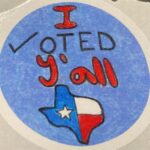Early voting in Texas started Monday and I was in the first wave of voters. It was a bit busy, and I spent my time in line guessing how every person was going to vote. Of course, my guesses could have been wrong, but I’d have bet good money on my accuracy for about 95% of the voters. I saw about 60 folks in line to vote in my purple county and the D/R split was about 50/50, with maybe a slight D tilt. I suspect that my micro-analysis is at least as accurate as most polls.
Speaking of polls, I don’t trust them at all. Many focus on the meaningless popular vote, most of the swing-state poll methodologies are flawed at best, and even the few good polls are merely snapshots of a past that is several news cycles old. Worse, most news organizations are either treating all polls the same or are aggregating all of them into some useless headline-grabbing number. The fact is that Republicans have flooded the market with partisan polls that get just as much attention as the decent polls. They also skew any aggregation. I don’t blame the GOP for the campaign tactic, but the mainstream media should know better.
However, one doesn’t need polls to know that this election is close. I frankly don’t understand how it’s close. But it is. As I’ve noted before, this election will be won or lost based on swing-state voter turnout. A large turnout should generally favor Democrats. A strong showing of young, female, and/or non-white voters should likewise favor Democrats. However, a preponderance of old white male voters will lead to a Republican win. [Please hold the vitriol. While these generalizations are definitely valid, I do realize that they are not universal truths. As an old white male that did NOT vote Republican, I rest my case.]
I never did manage to define a new predictive model with which I was completely happy. There are just too many new variables in this strange election and some of the data I needed wasn’t readily available. However, as sufficient swing-state early voting data becomes available, I may try to use it to perform some trend analyses. While no one knows how any given early voter voted, early voting data CAN reveal how many people have already voted, who they are, and where they voted. That data can then be modeled against publicly available voting histories and patterns to provide insights into how the parties are doing in comparison to each other and in comparison to past early voting results. Mainstream usage of this data has been limited in previous elections, but if a source I trust does the analysis this time, I’ll gladly lean on someone else’s work!
Bottom Line: Turnout is key.
Democrats: Please VOTE and VOTE EARLY!!!
Republicans: Please stay home.
